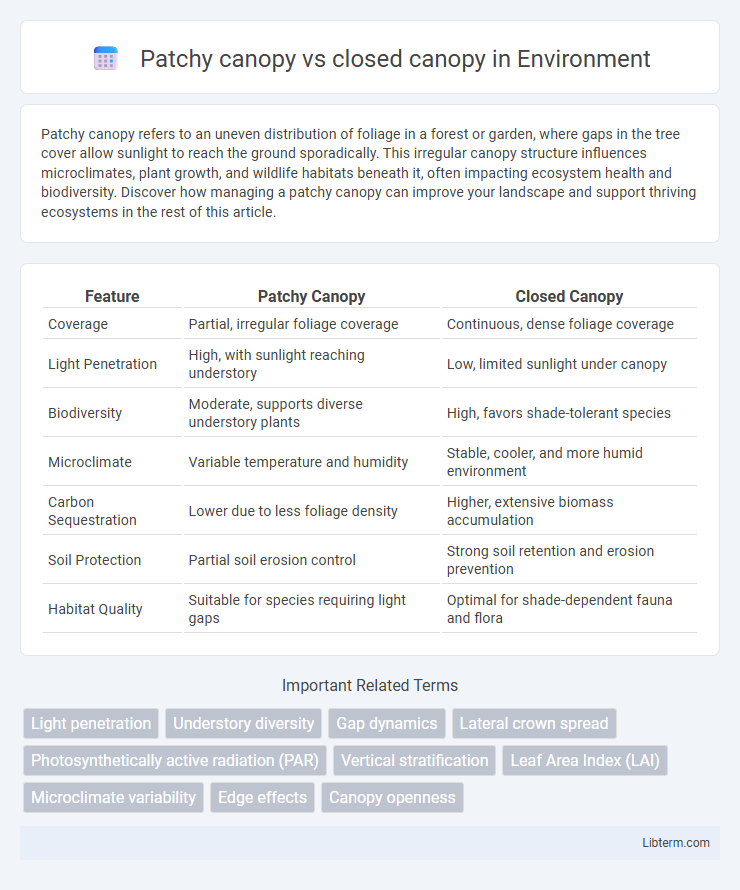Patchy canopy refers to an uneven distribution of foliage in a forest or garden, where gaps in the tree cover allow sunlight to reach the ground sporadically. This irregular canopy structure influences microclimates, plant growth, and wildlife habitats beneath it, often impacting ecosystem health and biodiversity. Discover how managing a patchy canopy can improve your landscape and support thriving ecosystems in the rest of this article.
Table of Comparison
| Feature | Patchy Canopy | Closed Canopy |
|---|---|---|
| Coverage | Partial, irregular foliage coverage | Continuous, dense foliage coverage |
| Light Penetration | High, with sunlight reaching understory | Low, limited sunlight under canopy |
| Biodiversity | Moderate, supports diverse understory plants | High, favors shade-tolerant species |
| Microclimate | Variable temperature and humidity | Stable, cooler, and more humid environment |
| Carbon Sequestration | Lower due to less foliage density | Higher, extensive biomass accumulation |
| Soil Protection | Partial soil erosion control | Strong soil retention and erosion prevention |
| Habitat Quality | Suitable for species requiring light gaps | Optimal for shade-dependent fauna and flora |
Defining Patchy Canopy and Closed Canopy
Patchy canopy refers to a vegetation structure where tree cover is irregular and gaps exist between clusters, allowing sunlight to penetrate to the forest floor. Closed canopy describes a dense and continuous layer of foliage where tree crowns overlap extensively, minimizing light penetration and creating a shaded understory. These distinctions impact biodiversity, microclimate, and ecosystem processes significantly.
Structural Differences Between Patchy and Closed Canopies
Patchy canopies feature irregular gaps and varying tree heights, creating heterogeneous light distribution and microhabitats that influence understory vegetation. Closed canopies present a continuous, dense layer of foliage with minimal gaps, resulting in uniform shade and reduced light penetration to the forest floor. Structurally, closed canopies support higher biomass and more stable microclimates, while patchy canopies exhibit diverse vertical stratification and dynamic ecological interactions.
Light Penetration and Microclimate Effects
Patchy canopies allow increased light penetration to the understory, promoting diverse plant growth and enhancing photosynthetic activity at lower levels. Closed canopies significantly reduce light availability, creating shaded microclimates with lower temperatures and higher humidity. These microclimate differences influence soil moisture retention, nutrient cycling, and habitat suitability for various forest species.
Impact on Biodiversity and Habitat Availability
Patchy canopies create a heterogeneous environment that enhances biodiversity by providing varied microhabitats and light conditions favorable for different species. In contrast, closed canopies limit understorey light penetration, reducing habitat diversity and favoring shade-tolerant species, which can lead to lower overall species richness. The structural complexity of patchy canopies supports greater fauna diversity and promotes ecological resilience.
Tree Species Composition in Patchy vs Closed Canopies
Patchy canopies typically support higher species diversity as varied light conditions allow both shade-tolerant and light-demanding tree species to coexist, promoting structural complexity. Closed canopies predominantly favor shade-tolerant species that thrive under continuous low light, resulting in more uniform species composition and reduced understory diversity. Tree species composition in patchy canopies often includes pioneer and early-successional species, while closed canopies are dominated by late-successional, shade-adapted species, influencing forest regeneration dynamics and habitat heterogeneity.
Influence on Understory Vegetation Growth
Patchy canopies allow greater sunlight penetration and variable microclimatic conditions, promoting diverse understory vegetation growth by enabling different species to thrive in light gaps. Closed canopies create a shaded and stable environment, limiting light availability and favoring shade-tolerant understory plants with slower growth rates. The influence of canopy structure on understory vegetation directly affects biodiversity, nutrient cycling, and forest regeneration dynamics.
Carbon Sequestration and Ecosystem Services
Closed canopy forests exhibit higher carbon sequestration rates due to dense biomass and continuous leaf cover that maximizes photosynthesis and carbon storage in aboveground vegetation. Patchy canopies support greater biodiversity and enhance ecosystem services such as habitat heterogeneity, nutrient cycling, and microclimate regulation, though they store less carbon overall compared to closed canopies. Both canopy types contribute uniquely to ecosystem resilience and carbon dynamics, with closed canopies prioritizing carbon stock accumulation and patchy canopies promoting ecological complexity.
Succession Patterns in Patchy and Closed Canopy Forests
Succession patterns in patchy canopy forests often exhibit increased species diversity and heterogeneity due to variable light availability and microhabitats, promoting early successional species alongside mature trees. Closed canopy forests typically demonstrate more uniform successional stages dominated by shade-tolerant species, resulting in stratified vegetation layers and slower understory development. These dynamics influence ecosystem processes such as nutrient cycling, regeneration rates, and habitat complexity within forested landscapes.
Human Impacts and Land Management Practices
Patchy canopies often result from selective logging, agricultural expansion, and grazing, which degrade forest structure and reduce biodiversity. Closed canopies are more resilient to soil erosion and microclimate fluctuations, typically maintained through sustainable land management such as controlled logging and reforestation efforts. Human impacts like deforestation and urbanization convert closed canopies into patchy landscapes, disrupting ecosystem services and altering habitat connectivity.
Conservation Strategies for Different Canopy Types
Conservation strategies for patchy canopy ecosystems prioritize habitat connectivity and edge effect management to support biodiversity and reduce species isolation. In contrast, closed canopy forests require efforts focused on maintaining microclimate stability and preventing selective logging that disrupts the dense overhead cover essential for shade-dependent flora and fauna. Tailoring conservation actions to these canopy structures enhances ecosystem resilience and promotes long-term species survival.
Patchy canopy Infographic

 libterm.com
libterm.com